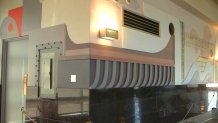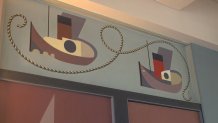A roomful of trippy, nautical-themed murals that were covered-over with paint 50 years ago, are emerging from a long restoration and open to the public for the first time in decades.
The murals, which include abstract renditions of tugboats and nautical symbols, have occupied the third floor of the historic Aquatic Park Bathhouse building at San Francisco’s northern waterfront since it opened in 1939. The iconic building — created in the shape of a ship — is marking its 80th anniversary this year.

“This is the first time anyone has seen this floor in its original condition in almost 50 years,” said National Park docent Alvin Rivera standing among the murals, beneath a light fixture shaped like a ship’s wheel.
The third floor murals were painted by artist Richard Ayer under the federal Works Progress Administration which also sponsored murals in Coit Tower and the Marina Branch of the San Francisco Public Library. Ayer’s murals and reliefs in the building survived until 1976 when they were covered over with white paint as part of a remodel job.
“This remodel did a lot of damage to the murals themselves,” said fine art restorer Anne Rosenthal.

In a recent effort to restore the murals, Rosenthal spent months painstakingly removing the paint and repainting the images — a feat made even more challenging by the lack of photos showing the room’s original appearance.
Local
“In coming in it was more like archaeology,” Rosenthal said, “to remove everything that had been put in.”
Rosenthal specifically wondered about a certain column in the room which lacked decoration — yet no one knew what might’ve been there. That mystery was partially solved when a National Parks archivist discovered footage of the Cal Berkeley class of 1917 holding its reunion in the room sometime around 1939. Although the video was dark, a fleeting glimpse revealed a pair of wooden sharks on the column. Rosenthal had seen the orphaned pair of wooden sharks in storage.
“So we were able to discern that a pair of wooden sharks that had long been in storage belonged on the wall,” Rosenthal said, taking in the fully restored room. Rosenthal believes the column is still missing a feature, perhaps a small fish fleeing from the sharks, and hopes someone might eventually come forward with a photo that can shed light on it.

Ayer’s images featured a pair of tugboats drifting over a doorway, a large ship wrapped around a wall, an actual cord of rope looped around a wall near a pair of relief fishes. The granite floor was also decorated in nautical motifs, and door knobs in the room were also shaped like ship’s wheels. The room’s windows opened up to sweeping views of the actual bay and historic ships bobbing on the nearby Hyde Street Pier.
“Everything in this building is deliberate,” Rosenthal said, “the walls, the floors, the hardware.”
The WPA program carried-out a long envisioned dream of transforming the industrial waterfront into Aquatic Park — which included the bathhouse building — intended as a nautical palace.
“For San Franciscans this has always been an institution,” said Rivera. “It’s always been a landmark.”
But it was a landmark no one was exactly sure what to do with it. For a while the building housed a restaurant, then military barracks during World War II. The city abandoned the building which was finally turned into a maritime museum in the 1950s.
The lobby of the building now houses model ships, maritime implements — a piece of the abandoned whaling vessel Niantic framed against the colorful underwater-themed murals of bohemian artist Hilaire Hiler. The lobby was intended as an underwater scene while Ayer’s third floor murals depict life on the water. Located just beyond the far edge of Fisherman’s Wharf, the building is something of an unexpected destination.
“I think that a lot of San Franciscans recognize this building but never come in to see it,” said Rosenthal. “It’s entirely unique, I’ve never seen anything like it.”
Visitors and locals alike will have an added reason to visit the building now that it’s been entirely restored from top to bottom — and the upstairs murals now open to the public — a version most likely as impressive as the day it opened eighty years ago.



